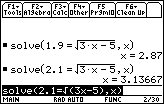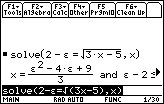In the previous lesson you found tolerances graphically. In this lesson you will use the TI-89 computer algebra system to find these tolerances symbolically. This will prepare you to generalize the tolerances and develop the definition of limit.
Tolerances
The first tolerance you found in lesson 4.1 was in response to the question
-
How close should x be to 3 so that
Restate the Question
Another way to phrase this question is
-
Find a positive number
Given y-Tolerance, Find x-Tolerance
The x-tolerance when the y-tolerance is 0.1 can be found by solving the
compound inequality
![]()
![]()
A compound (or extended) inequality is an inequality that compares more than two quantities and contains more than one inequality symbol.
![]()
![]()
![]() < 2.1.
< 2.1.![]() and
and
![]() = 2.1.
= 2.1.![]()
![]() or set the mode to AUTO.
or set the mode to AUTO.

The solution is approximately 2.87 < x < 3.13667.
Notice that the solutions are the same as those found in Lesson 4.1 when you used the intersection feature.
Finding
![]()
Compare 2.87 < x < 3.13667 with the inequality 3 –
![]() < x < 3 +
< x < 3 +
![]() . It must follow that 3 –
. It must follow that 3 –
![]()
![]() 2.87 and 3 +
2.87 and 3 +
![]()
![]() 3.13667 . However, solving these two equations for
3.13667 . However, solving these two equations for
![]() yields two different values:
yields two different values:
![]()
![]() 0.13 and
0.13 and
![]()
![]() 0.13667. As in lesson 4.1, the smaller of the two values is the correct answer:
0.13667. As in lesson 4.1, the smaller of the two values is the correct answer:
![]()
![]() 0.13.
0.13.
Smaller Tolerance
The second tolerance you found in lesson 4.1 came from answering the question
-
How close should x be to 3 so that
4.2.1 Rephrase this question with compound inequalities. Click here for the answer.
4.2.2 Use the solve( command to solve the first compound inequality. Click here for the answer.
4.2.3 Compare your answer to 4.2.2 with the inequality 3 –
![]() < x < 3 +
< x < 3 +
![]() and find a value of
and find a value of
![]() , the x-tolerance. Click here for the answer.
, the x-tolerance. Click here for the answer.
Finding a Generalized Solution
Suppose that you are asked to find values of
![]() that correspond to smaller and smaller tolerances for y around y = 3. Rather than going through the same process over and over for various y-tolerances, you could solve the problem once with a generalized y-tolerance. Call this general y-tolerance
that correspond to smaller and smaller tolerances for y around y = 3. Rather than going through the same process over and over for various y-tolerances, you could solve the problem once with a generalized y-tolerance. Call this general y-tolerance
![]() , the Greek letter "epsilon." The Greek letters delta,
, the Greek letter "epsilon." The Greek letters delta,
![]() , and epsilon,
, and epsilon,
![]() , will be used to represent small positive numbers.
, will be used to represent small positive numbers.
The tolerance question then becomes
-
How close should x be to 3 so that
Rephrasing the Question
The question can be rephrased using inequalities as
-
Find a positive number
Solving the Left Inequality: 2 –
![]() <
<
![]()
-
Solve the left side of the inequality 2 –
 <
<
 < 2 +
< 2 +
 with the command
with the command
The Greek letter
![]() can be entered in the TI-89 by pressing
can be entered in the TI-89 by pressing
![]()
![]()
![]()
![]() .
.

The solution to the equation has two parts:
![]() and
and
![]() – 2
– 2
![]() 0.
0.
The second part of the solution,
![]() – 2
– 2
![]() 0, is always true because
0, is always true because
![]() is a small positive number.
is a small positive number.
|
|||
|
|
|||
Solving the Right Inequality:
![]() < 2 +
< 2 +
![]()
You can edit the command shown in the Edit Line to solve the right inequality by changing the "–" sign to "+."
-
Edit the expression on the Edit Line to read solve(2+
 =
=
 (3x–5),x) by using the cursor movement keys and
(3x–5),x) by using the cursor movement keys and

-
Execute the command by pressing


The solution is
![]() and
and
![]()
![]() – 2.
– 2.
Because
![]() is a small positive number, the statement
is a small positive number, the statement
![]()
![]() – 2 is always true.
– 2 is always true.
Combining the solutions to find
![]()
Combining the two solutions, in order to have 2 –
![]() <
<
![]() < 2 +
< 2 +
![]() we need
we need
Comparing this inequality with 3 –
![]() < x < 3 +
< x < 3 +
![]() yields
yields
Solving these equations
for
![]() gives
gives
![]() and
and
![]()
The smaller of these two values is
![]() , which is the general solution. Given any value for
, which is the general solution. Given any value for
![]() you can use this equation to find the corresponding value for
you can use this equation to find the corresponding value for
![]() . For example, when
. For example, when
![]() = 0.01, this equation gives
= 0.01, this equation gives
![]() = 0.0133, the same value we found earlier.
= 0.0133, the same value we found earlier.
Limits
When the values of the output can be made as close as we like to 2 by taking input values sufficiently close to 3, we say
-
The limit of the function f(x) =
That is, the value of f(x) =
![]() gets closer and closer to 2 as x gets closer and closer to 3.
The notation used to indicate this is
gets closer and closer to 2 as x gets closer and closer to 3.
The notation used to indicate this is
which is read "the limit of
![]() as x approaches 3 is 2."
as x approaches 3 is 2."
In the previous example we found that
![]() guarantees that
guarantees that
Because for any positive
![]() , a corresponding positive
, a corresponding positive
![]() can be found that meets the conditions above,
can be found that meets the conditions above,
Definition of Limit
Formally,
![]() if for any
if for any
![]() > 0, however small, there exists a
> 0, however small, there exists a
![]() > 0 such that
> 0 such that
Conceptually, f(x)
![]() L as x
L as x
![]() a.
a.
4.2.4 Write the inequality with conditions that is associated with the limit. Interpret
![]() .
.
Click here for the answer.